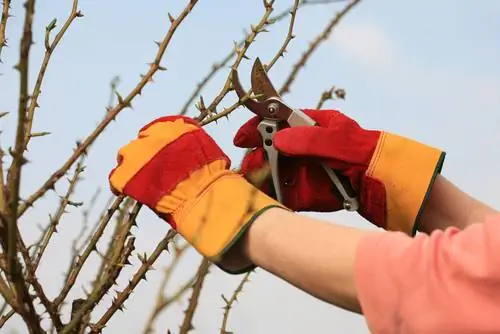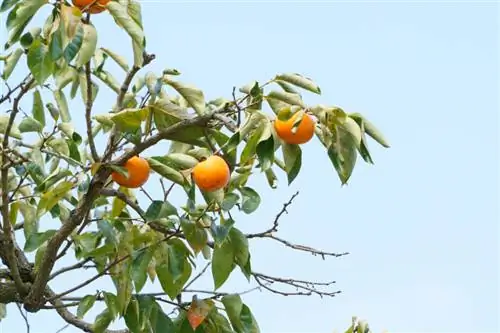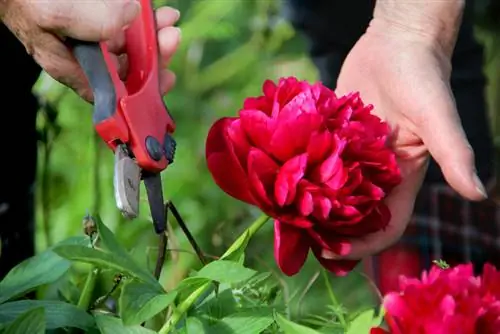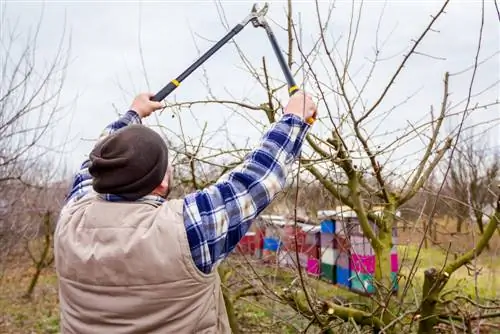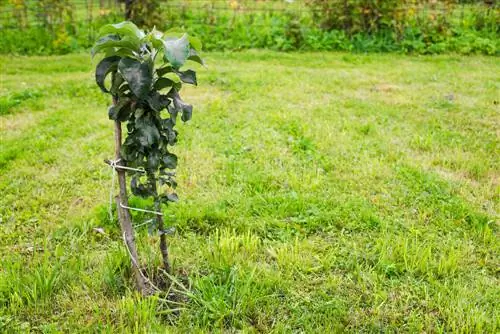- Author admin [email protected].
- Public 2023-12-26 14:17.
- Last modified 2025-06-01 06:02.
The pruning care of shrub roses depends largely on the flowering behavior. Park roses that bloom once are cut differently than varieties that bloom more often. Learn when and how to properly prune shrub roses in this tutorial.
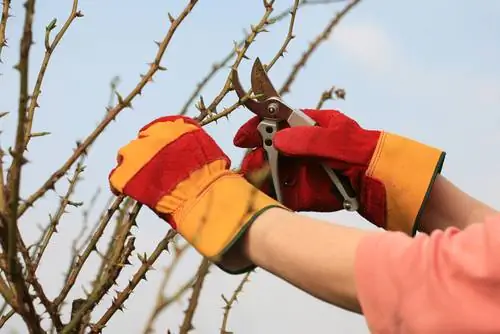
When and how do I cut shrub roses correctly?
You cut out shrub roses that bloom more frequently in spring by removing dead, cross-growing and unfavorably positioned shoots and shortening last year's growth and side shoots. Once-flowering varieties are pruned after their flowering period, with excessively long or annoying shoots being removed.
Cutting shrub roses that bloom more often
Modern shrub roses and numerous English roses enchant us with a two-time flower festival. The floral masterpiece is achieved when the buds of thefirst flowering periodunfold from June onperennial wood. Thesecond flower pileshines from the end of July onthis year's shoots With an annual cut in spring you support growth habit and flowering. How to properly cut remontant park roses:
- The best time is when the forsythia blooms
- Thin out dead, cross-growing and unfavorably positioned shoots
- Cut back last year's growth of the main ground shoots by a third or half
- Short side shoots along the scaffold shoots to 3 to 5 eyes
- Cut away stunted, decaying shoots at the base
The image below illustrates the pruning procedure on a medium-growing shrub rose. If you haven't already done so in the fall, cut off the wilted flower heads and rose hips now in the spring. Is a remontant park rose with poor growth giving you grief? Then you can cut more boldly. The main shoots easily tolerate cutting by up to two thirds. A massive sap buildup occurs below the interfaces, which triggers vigorous sprouting. However, if a shrub rose is growing over your head, limit the cutting to what is absolutely necessary to calm the growth.

Thoroughly thin out shrub roses that bloom more frequently in spring. Shorten the growth of the scaffold shoots by a third or half. Intersect their side branches to three to five eyes. Weak side shoots are completely removed.
Background
Cutting guide - key to success
Don't cut your shrub roses just anywhere. Choose the starting point for the rose scissors in the immediate vicinity of an eye, a slight thickening on the shoot. Gardeners call an eye a bud that later turns into a flower, a leaf or a shoot. The ideal distance to the floral hotspot for roses is 5 to 10 millimeters. Hold the scissors at a slight angle so that rain and irrigation water can drain away as quickly as possible. If you choose a distance that is too short, you could cut into the eye. At a distance of more than 10 millimeters you leave a long stub that dries back and opens the door to pathogens.
Summer pruning maximizes flowering potential
After the first bloom, rose gardeners pull out the scissors again. Withered flower heads not only spoil the well-groomed appearance, but also shade the buds for the second round of flowering. Make the cut justabove the first complete, he althy leaflet. This clears the way for the swelling buds that will decorate your shrub rose until the first frost.
Tip
Summer pruning is the ideal opportunity for a well-measured portion of rose fertilizer. To ensure that your replanting shrub roses don't run out of floral steam after the first round of flowering, give their growth new impetus with a special fertilizer for roses.
Cutting single-blooming shrub roses
Single-blooming shrub roses produce their buds the previous year. The opulent flowering period extends from May/June to June/July. This flowering behavior prohibits vigorous pruning in spring, as is mandatory for remontant shrub roses. Shortly before growth begins, moderate pruning ensures order. More in-depth pruning measures are carried out after the flowering period and before bud formation. This is how you prune once-blooming shrub roses in an exemplary manner:
- Cut out wilted flowers and rose hips in late February to early March
- Thin out dead wood, sick and stunted shoots
- After flowering, cut back long shoots that protrude from the bush shape
- Ideally derived from a lower side shoot
From the fifth or sixth year onwards, shrub roses benefit from continuous rejuvenation. To do this, remove the oldest ground shoot just above the grafting point, unless it is a grafted shrub rose. On wild roses, cut off the relevant scaffold shoot at ground level. A sap is created, which promotes the growth of young ground shoots as future scaffold shoots.
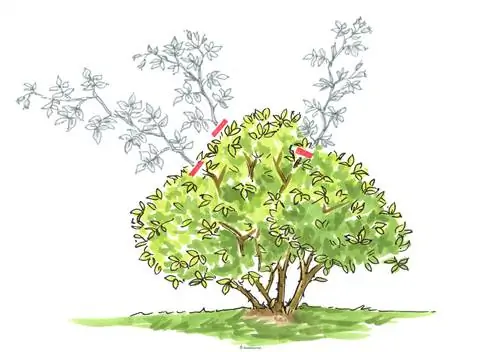
Once-flowering shrub roses tend to form annoying long shoots after flowering that protrude out of shape. Cut back excessively long branches in late summer. This preserves the shapely habit and promotes the growth of short flower shoots for the next year.
Excursus
Shrub roses are not climbing roses
Majestic growth up to lofty heights of 200 centimeters leads many home gardeners to consider shrub roses as climbing roses. In fact, shrub roses achieve their impressive heights on their own and do not rely on a trellis. Climbing roses, on the other hand, transform facades and other surfaces into a sea of flowers, provided a climbing aid is available. In this case, the floral climbing artists conquer dizzying heights of up to 10 meters. The specific growth influences pruning care. A separate tutorial is dedicated to the correct cutting of climbing roses.
Cutting small shrub roses
Since garden areas have become smaller and smaller, small shrub roses have been on the rise. With a growth height of 50 to 100 centimeters, the small-format shrub roses transform the garden into a summer floral fairytale. The compact growth habit depends primarily on vigorous pruning in the spring. How to cut small shrub roses correctly:
- Best time is in spring
- Thoroughly thin out the entire bush in advance
- Cleaning up wilted flowers and dead leaves
- Cut sick, brown, black shoots back to light, he althy wood
Following the cleanup, focus on shaping. Cut all remaining shoots back to 30 or 40 centimeters. Place the cut 0.5 centimeters above an outward-facing eye. Cut at a slight angle so that the highest point of the cut is directly above the eye.
Small shrub roses stay young and blooming if you combine spring pruning with continuous rejuvenation. From the third or fourth year onwards, remove the oldest ground shoot. On grafted roses, please cut above the grafting point. On wild roses, place the scissors just above the ground.
Frequently asked questions
Should bare-root shrub roses receive a planting cut? If yes, when and how do I cut correctly?
The best time to plant bare-root shrub roses is in autumn. Since cutting so close to winter can cause frost damage, the plant is not cut until the following spring. Only cut back excessively long or damaged root strands to 20 to 25 cm before planting. When the forsythia blooms next year, cut all the shoots of a young shrub rose to 3 to 5 eyes. The weaker a shoot, the stronger the pruning.
I planted the shrub rose 'Westerland' last September with a height of 120 cm. How high do I cut the rose back in spring?
Primarily cut out dead and damaged wood. Branches that grow inwards and rub against each other are also cut away. Leave vigorously growing shoots standing or shorten the tips by a maximum of a third. Encourage weak shoots to grow vigorously by cutting them to 2 to 3 eyes. Cut remaining branches back to 4 to 5 eyes.
On my shrub rose, a very long, soft shoot develops on the previous year's shoot, which can be easily broken off. Do such shoots have to be completely removed?
Strikingly long, soft shoots are called horny shoots. Long periods of cloudy weather or a location with little light cause shrub roses to grow such shoots. As a rule, it is sufficient to shorten a horny shoot by half. However, it cannot be ruled out that it is a wild shoot that sprouts from the rootstock. In this case, remove the entire shoot completely, ideally by tearing it off.
Two years ago I planted a shrub rose that blooms more often. It is now thriving with 2 strong, approximately 140 cm long branches and thin side shoots. How far should I prune the rose in spring?
It is largely up to you as a gardener to decide how deeply you cut back a shrub rose that blooms more often. You can either cut the two main shoots back by half or just cut off the tips. When measuring the cutting circumference, please keep in mind that rose bushes branch directly below the cut. The stronger the pruning, the bushier and more compact the growth. Since more shoots grow as a result, the shrub rose bears more flowers. You should cut back the weak side shoots to 2 to 3 eyes in order to strengthen growth.
The 3 most common cutting mistakes
If you cut your shrub rose that blooms once like a variety that blooms more often, you will struggle with the loss of flowering time. Completely neglecting pruning care results in an unsightly, almost flowerless thicket. Anyone who treats their park roses with arbitrary pruning will trigger morbid consequences. So that you don't have to struggle with such damage, this overview names common cutting errors with tips for skillful prevention:
| Cutting errors | malicious image | Prevention |
|---|---|---|
| Single-blooming rose cut like a multiple-blooming rose | Failure of flowering period | cut once-flowering shrub roses in late summer |
| arbitrary cutting | Growth depression, dried buds, disease attack | Cut 5-10 mm diagonally above one eye |
| never cut | Clearing into impenetrable, flower-poor thickets | cut or thin once a year |

Tip
In the rose bed, modern gardeners pull out the scissors again in autumn so that replanting shrub roses present a well-groomed appearance during the winter. Withered flowers and dead leaves are removed. If excessively long shoots prevent the installation of winter protection, cut off the branch tips by a maximum of a third.

